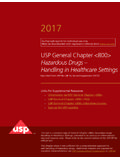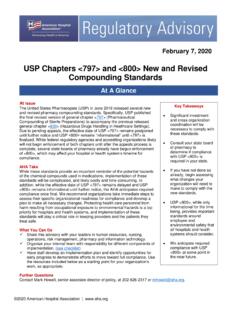Transcription of USP <800> USP 800> Hazardous Drugs-Handling in …
1 USP 800> Hazardous Drugs-Handling in healthcare SettingsUSP <800>Impact on Community PharmaciesCharles Lager RPh, MBAT hursday, April 8, 2021 Agenda About USP <800> Potential Risks Types of Exposure NIOSH Scope of <800> <800> Compliance Personnel Facility Community Pharmacy Implications QuestionsAbout United States Pharmacopeia (USP) USP, a scientific organization that sets standards for identity, strength, quality, and purity of medicines, food ingredients, and dietary supplements manufactured, distributed and consumed worldwide. USP s standards are enforceable in the by the Food and drug Administration. Council of Experts Six Separate Councils Compounding falls under healthcare Quality Standards Collaborative Group General Chapters terminology Shall or Must = required Should = recommendationRevision TimelinesWhat is Exposure?
2 Protect patients, personnel and the environment from exposure to Hazardous drugs Applies to all healthcare settings Applies to all personnel More than 8 million workers are exposed to Hazardous drugs every year More than 12 billion doses of Hazardous drugs are handled by US providers each yearWhat are the Potential Risks? To healthcare Worker Cancer Infertility Reproductive Outcomes Symptoms Hair Loss Cardiac Toxicity Hearing Loss Nausea RashesWho is at Risk? Pharmacists Pharmacy Technicians Nurses Physicians Physician Assistants Home Health Aides Housekeeping Janitorial Services Environmental Services VeterinariansTypes of Exposure Vehicle / Route Dermal absorption Mucosal absorption Inhalation Injection Ingestion How / Where Receipt Dispensing Compounding & other manipulation Administration Patient Care Activities Spills Transport WasteNIOSHList Tables2004-2010-2012-2014-2016 Next Published ?
3 ???? Examples: BC Control Hormone WarfarinWhat is a HD?Any drug identified by at least one of the following criteria:Scope of USP <800>Approach to ComplianceKey Steps to Compliance Review the NIOSH list Divide into two lists Follow containment requirements in USP <800> Perform an Assessment of Risk (AOR) Identify the drugs and dosage forms that are stocked Determine your approach Two handling options: Treat all dosage forms of all HDs the same Follow containment requirements of USP <800> Identify & use alternative containment strategies and/or work practices for specific dosage forms of HDs that are not antineoplastic agents or are not Active Pharmaceutical Ingredients (API)Assessment of Risk (AOR) Minimum Considerations Type of HD Dosage form Risk of exposure Package ManipulationPersonnel Requirements Compounding personnel (if applicable)
4 Must be qualified and trained Understand fundamental practices and precautions Continually evaluate these procedures Continually evaluate final HD preparations Minimize exposure to personnel Minimize contamination of the environment Must have a designated person assigned to oversee Personnel of reproductive capability must confirm in writing that they understand the risks of handling HDs Demonstration of competency must be documented every 12 monthsPersonal Protective Equipment (PPE)SOP s Required Receipt Storage Transport Compounding Administration Cleaning Spill Control Waste DisposalCommunity PharmacySteps to ComplianceStep One Assessment Must have P&P s addressing Receipt; Storage; Compound; Dispense; Disposal Assessment of Risk If any manipulation is required If on the NIOSH list Crushing tablets or opening capsules to make a suspension Splitting tablets No option, must treat with all the containment strategies and work practices in <800>Step Two Receiving Can you tell from the outside of your packages that a Hazardous drug is inside?
5 Do you have any anti-neoplasticsthat must be manipulated other than counted or packaged? Need to identify specific to drug and dosage form those agents that will be handled differently from <800> and identify strategies in your Assessment of RiskStep Three Work Practices Identify HDs by bins or shelf stickers Buy in unit-of-use when possible Use separate equipment for HD s Designated counting tray and spatula Wear chemo gloves tested to ASTM D6978 Decontaminate tray after use No HD sto be placed in automated dispensing machines or pill countersStep Four drug Storage Identify as HDs Store in yellow, lidded bins Clearly note what must be done if manipulation of the dose is requiredHazardous Drugs vs Hazardous MaterialsStep Five HD Disposal Expired HD sare very costly to your Pharmacy What to do: Pull HD s 9 months prior to expiration Unless you are guaranteed to dispense What is Hazardous waste?
6 Includes empty vials or dust / residue in containers Empty HD containers must be labeled as Hazardous waste Dispose via the EPA s Resource Conservation & Recovery Act (RCRA) rulesWhat Evidence Your TCT Surveyor will be evaluating Your Compliance to: Policy & Procedures Assessment of Risk documented annually Personnel Training and documentation Work Practices Receiving and Inventory control of HD s DisposalQuestionsThank YouCharles Lager RPh, MBAS enior Pharmacy






